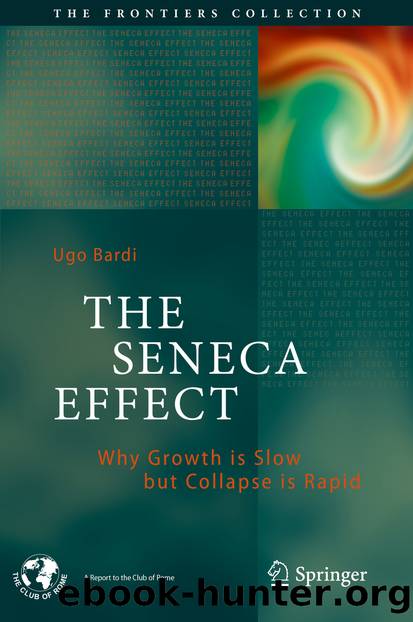The Seneca Effect by Ugo Bardi

Author:Ugo Bardi
Language: eng
Format: epub
Publisher: Springer International Publishing, Cham
This is a very general idea that we might apply, for instance, to the whaling industry where the production of whale oil should be proportional to the product of the number of whaling ships and the number of whales. We can also apply it to many other cases and, in this form, it is a simplified version of what economists call the “production function.”
There is a problem in writing the production function in this way: it implies constant returns to scale. That is, if you double one of the factors, production doubles, too. But that can’t be: if you double the area of land available, production won’t double unless the number of sheep increases in proportion. The same is true if you increase the number of sheep without proportionally increasing the area of the grassland. Because of this, economists have developed a form of the production function where each factor is raised at an exponent smaller than one. These exponents are called “elasticities” and they have the effect that the function doesn’t rise linearly in proportion to the size of each component but tapers down gradually as it grows. In this form, the formula is known as the “Cobb-Douglas” function [172] and it is often able to describe economic systems of various sizes. For instance, in 1956 Robert Solow used it to describe the GDP of the American economy obtaining a result that’s still widely known today, a continuous exponential growth that both politician and the public seem to have taken for granted for the economy [173].
The problem with this kind of production function is that it can’t describe collapses; which nevertheless happen. So, we need a different mathematical approach. We can find it in a well-known model in population biology developed in the 1920s, independently, by Alfred Lotka [174] and Vito Volterra [175]. The model is known today as the “Lotka-Volterra” (LV) model. Sometimes it is also known as the “predator- prey” model or the “foxes and rabbits” model. The relation between the LV model and Hardin’s tragedy is known [176]. Basically, the LV model is a quantitative description of the overexploitation mechanism proposed by Hardin.
You’ll find details on the LV model in the appendix, but here I’ll describe it in a synthetic way. It is based on two coupled differential equations where the simple production function that we saw before is just one term. Further terms describe the feedback phenomena of the system: there is a growth factor for the resource (the prey population) that’s proportional to the amount of the resource, to consider the fact that it is renewable. Then, there is a second equation that describes the production of capital (the growth or decline of the predator population) as proportional to the production of the resource. Finally, a further term is the decay of the capital (of the predator population) to describe the natural entropic factor that dissipates the energy potential of the system.
We can write the Lotka-Volterra equations taking “C” as standing for capital (predator population) and “R” for resources (prey population).
Download
This site does not store any files on its server. We only index and link to content provided by other sites. Please contact the content providers to delete copyright contents if any and email us, we'll remove relevant links or contents immediately.
International Integration of the Brazilian Economy by Elias C. Grivoyannis(57319)
The Radium Girls by Kate Moore(10907)
Turbulence by E. J. Noyes(7037)
Nudge - Improving Decisions about Health, Wealth, and Happiness by Thaler Sunstein(6633)
The Black Swan by Nassim Nicholas Taleb(6190)
Pioneering Portfolio Management by David F. Swensen(5605)
Rich Dad Poor Dad by Robert T. Kiyosaki(5147)
Zero to One by Peter Thiel(4824)
Man-made Catastrophes and Risk Information Concealment by Dmitry Chernov & Didier Sornette(4735)
Secrecy World by Jake Bernstein(3782)
Millionaire: The Philanderer, Gambler, and Duelist Who Invented Modern Finance by Janet Gleeson(3568)
Skin in the Game by Nassim Nicholas Taleb(3459)
The Age of Surveillance Capitalism by Shoshana Zuboff(3422)
The Money Culture by Michael Lewis(3284)
Skin in the Game: Hidden Asymmetries in Daily Life by Nassim Nicholas Taleb(3264)
Bullshit Jobs by David Graeber(3179)
The Dhandho Investor by Mohnish Pabrai(3168)
The Wisdom of Finance by Mihir Desai(3077)
Blockchain Basics by Daniel Drescher(2890)
